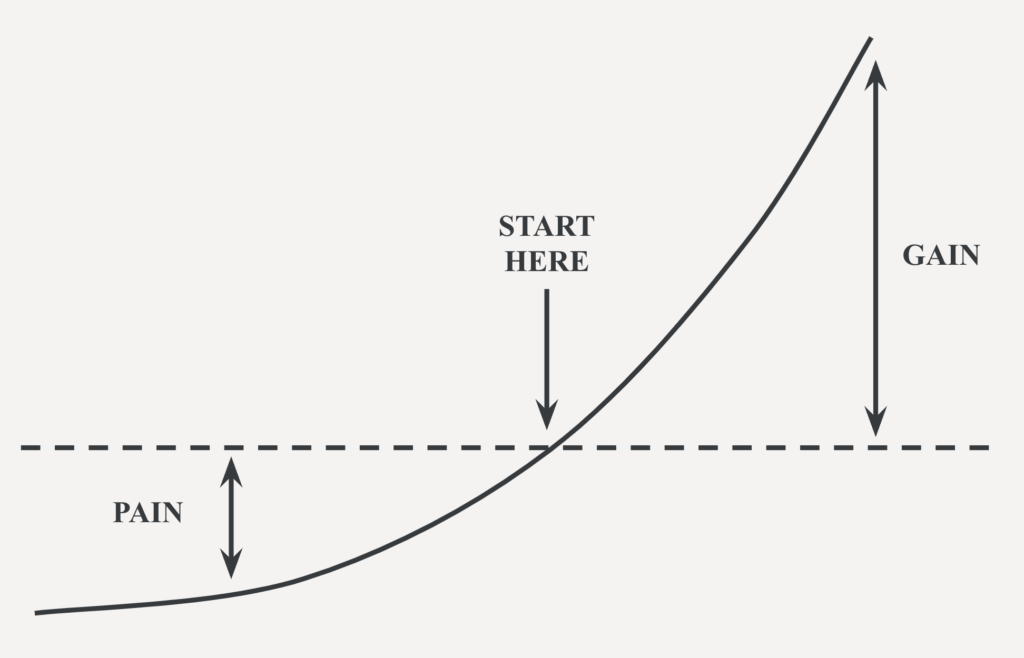We are obsessed with optionality. Not sure what to do with your life? Get a degree. Not quite sure what to do with this degree? Go to grad school. Still not quite sure? Get a consulting role at a big firm so you can decide what kind of job you enjoy. And so on and so forth. We fall prey to the optionality fallacy.
The problem is not with optionality itself. The problem is that we tend to assume optionality is built by keeping as many doors open for as long as possible. As Erik Torenberg puts it, it can be “like spending your whole life filling up the gas tank without ever driving.”
The conventional path of accumulating optionality gives you reassuring but fragile options. In contrast, the best options — which involve lots of experimenting and tinkering — may feel riskier in the short term but will help you thrive through uncertainty.
Optionality as convexity
Traditional approaches to optionality assume a linear life curve, with a linear dependence on the parameters — if do this, you get that. People “follow safe paths that cap their downside, not realising that they also cap their upside,” says Torenberg. He adds: “Many ambitious people, even though they understand this intellectually, still prefer the more conventional paths of accumulating optionality.”
It is often true that if all goes to plan, that is, if the actual parameters do end up looking highly similar to what they anticipated, following the traditional path will result for most people in a mostly predictable result.
But the reality is, life’s curve is non-linear. There are few things more uncertain and complex than your life path. Each day brings its own unpredictable challenges and random events. Inject an adverse event, such as losing your job, or a lucky one, such as inheriting a large sum of money, and the pains or gains will often be amplified in a non-linear way.
So, how can you design a life that embraces the random nature of reality? By having an approach to life which will result in larger gains than pains in a random environment.
Functions with larger gains than pains are “nonlinear-convex”. The graph below shows the effect of a random event which causes more gain than pain. Things go well? Great upside. Not so well? Limited downside. The performance curves outwards, making it convex.

And optionality is what gives it these crucial properties. Because you have options, you can discard the results when something doesn’t go well, thus limiting your losses. This allows you to experiment more, take more risks, and increase your chances of a big upside while capping the potential downsides.
“It is in complex systems, ones in which we have little visibility of the chains of cause-consequences, that tinkering, bricolage, or similar variations of trial and error have been shown to vastly outperform the teleological* — it is nature’s modus operandi. But tinkering needs to be convex; it is imperative.” says Nassim Nicholas Taleb. “Critically we have the option, not the obligation to keep the result, which allows us to retain the upper bound and be unaffected by adverse outcomes.”
*From the Merriam-Webster dictionary: “A teleologist attempts to understand the purpose of something by looking at its results. A teleological philosopher might argue that we should judge whether an act is good or bad by seeing if it produces a good or bad result, and a teleological explanation of evolutionary changes claims that all such changes occur for a definite purpose.”
Taleb calls the difference between the results of trial and error in which gains and harm are equal (a linear function), and one in which pains and gains are asymmetric (a non-linear convex function) the “convexity bias” — the more convex the function (bigger difference between potential harm and benefits) and the more random the environment (higher volatility), the larger the bias. As humans tend to hate uncertainty, we have a propensity to miss the volatility property.
In random, complex environments, convexity is easier to attain than knowledge. “Under some level of uncertainty, we benefit more from improving the payoff function than from knowledge about what exactly we are looking for,” says Taleb. In other words, when the future is uncertain, we benefit even more from performing experiments with a convexity bias that could lead to a big pay-off but have limited potential downside.
Optionality through thoughtful tinkering
Most ambitious people spend a lot of time and energy accumulating what feels like optionality by competing for a degree from a reputable university, then a prestigious work placement, and so on.
Accumulating popular skills may feel like a path to more optionality, but the issue is: we don’t know what we don’t know. We cannot guess what skills will be helpful in the future, what random events (positive or negative) life will throw at us.
In a complex system such as life, where you have limited visibility of the chains of cause and consequences, you are better off using trial and error. Tinkering and experimenting is a more efficient investment of your time than following a set path of learning which assumes an intrinsic value in specific skills and ignores the non-linear way life works.
Experimenting does not mean giving something a quick try and abandoning it if you don’t see immediate results. Taleb gives the example of technologists in California who instead of investing based on narratives that look good on paper (assuming linearity), opportunistically switch or ratchet up their investments. This whole process takes many years of tinkering. “Typically people try six or seven technological ventures before getting to destination — note the failure in strategic planning to compete with convexity,” writes Taleb.
To increase your optionality, apply the same to your life. It may mean taking a job in a new, unproven industry; investing in an emerging skill; learning an uncommon language; understanding a lesser-known culture; solving a hard problem few people are looking at. Rely on a series of experiments rather and avoid following a pre-defined narrative.
Take these experiments seriously. Stay focused and give them your all. Go through a full cycle of deliberate experimentation before you decide whether you want to continue following this path, or if you would rather explore another path.
And remember—you don’t only live once. One day you will be dead, but it takes about seven years to master something. If you live to be 88, after age 11, you have 11 opportunities to be great at something.
Most people never let themselves die and cling onto that one life. But you can spend a life building things, another life writing poems, and another life looking for facts. You have many lives. Each of them is an opportunity to learn and grow. Live them.
